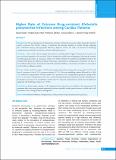Please use this identifier to cite or link to this item:
https://hdl.handle.net/20.500.14356/1176Full metadata record
| DC Field | Value | Language |
|---|---|---|
| dc.contributor.author | Paudel, Subash | - |
| dc.contributor.author | Shah, Pradeep Kumar | - |
| dc.contributor.author | Adhikari, Prashanna | - |
| dc.contributor.author | K. C., Sanjay Singh | - |
| dc.contributor.author | Shrestha, Upendra Thapa | - |
| dc.date.accessioned | 2023-05-02T06:18:42Z | - |
| dc.date.available | 2023-05-02T06:18:42Z | - |
| dc.date.issued | 2021 | - |
| dc.identifier.citation | PaudelS., ShahP. K., AdhikariP., Singh K. C.S., & Thapa ShresthaU. (2022). Higher Rate of Extreme Drug-resistant Klebsiella pneumoniae Infections among Cardiac Patients. Journal of Nepal Health Research Council, 19(04), 661-668. https://doi.org/10.33314/jnhrc.v19i04.3524 | en_US |
| dc.identifier.issn | JNHRC Print ISSN: 1727-5482; Online ISSN: 1999-6217 | - |
| dc.identifier.uri | http://103.69.126.140:8080/handle/20.500.14356/1176 | - |
| dc.description | Original Article | en_US |
| dc.description.abstract | Abstract Background: The accelerating rate of carbapenems resistance in Klebseilla pneumoniae isolates has put the treatment option worrisome. The effective strategy to ameliorate this alarming situation is possible through enhancing the combination therapy and appropriate laboratory diagnosis. Hence, the study was focused on identifying carbapenemase-producing K. pneumoniae and their antibiogram pattern. Methods: A total of 944 clinical samples from patients attending Sahid Gangalal National Heart Center were processed from September 2019 to March 2020 to identify the possible bacterial pathogens following the standard microbiological procedures. K. pneumonaie isolates were further subjected to antibiotic susceptibility testing by the modified Kirby Bauer disc diffusion technique. Phenotypic confirmation of carbapenemase production was done by the modified carbapenemase inactivation method. The minimum inhibitory concentration of colistin was determined by the broth microdilution method. Results: Of the total 944 samples, 15.47% (146) samples showed bacterial growth, among which 23.97% (35) were K. pneumoniae. Out of 35 K. pneumoniae isolates, 45.71% (16) were multidrug-resistant followed by 42.86% (15) extensively drug-resistant. Fourteen isolates of K. pneumoniae were carbapenemase producers among which 20% (7) were serine carbapenemase while 20% (7) showed metallo-?-lactamase production. All the carbapenemase-producing K. pneumoniae were susceptible to colistin with <0.125µg/ml. Carbapenemase activity showed statistically significant with multidrug resistance (p=<0.05). Conclusions: An increasing resistance to the carbapenem drugs showed a great problem in the management of K. pneumoniae infections among immunocompromised patients especially cardiac patients however, colistin can be still an ultimate choice of drug for disease management. Keywords: Broth microdilution; carbapenemase; colistin; extreme drug-resistant; klebsiella pneumonia. | en_US |
| dc.language.iso | en | en_US |
| dc.publisher | Nepal Health Research Council | en_US |
| dc.relation.ispartofseries | Oct-December, 2021;3524 | - |
| dc.subject | Broth microdilution | en_US |
| dc.subject | Carbapenemase | en_US |
| dc.subject | Colistin | en_US |
| dc.subject | Extreme drug-resistant | en_US |
| dc.subject | Klebsiella pneumonia | en_US |
| dc.title | Higher Rate of Extreme Drug-resistant Klebsiella pneumoniae Infections among Cardiac Patients | en_US |
| dc.type | Journal Article | en_US |
| local.journal.category | Original Article | - |
| Appears in Collections: | Vol. 19 No. 04 (2021): Vol 19 No 4 Issue 53 Oct-Dec 2021 | |
Files in This Item:
| File | Description | Size | Format | |
|---|---|---|---|---|
| 3524-Manuscript-26765-1-10-20220313.pdf | Fulltext Article. | 1.09 MB | Adobe PDF |  View/Open |
Items in DSpace are protected by copyright, with all rights reserved, unless otherwise indicated.
